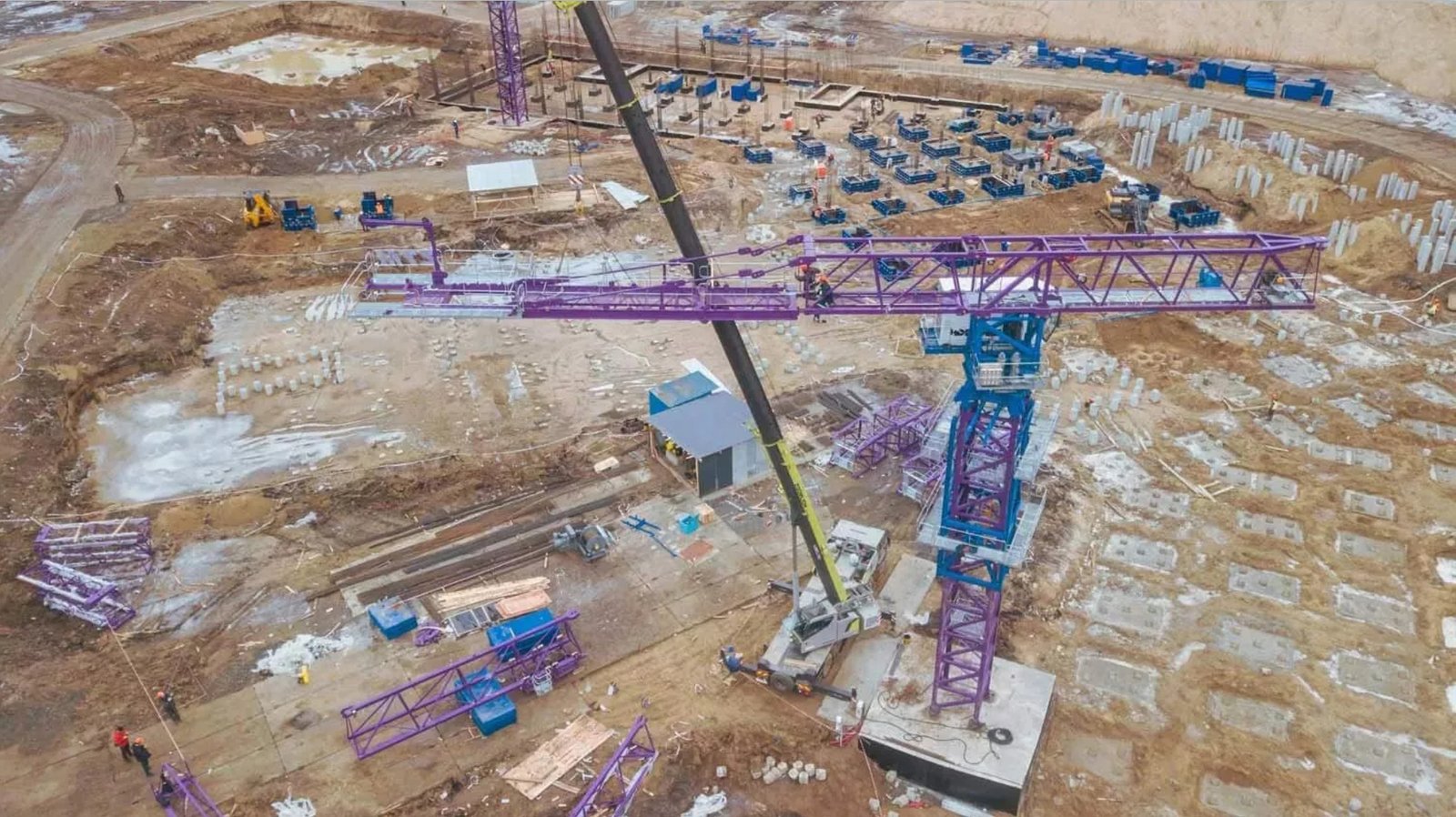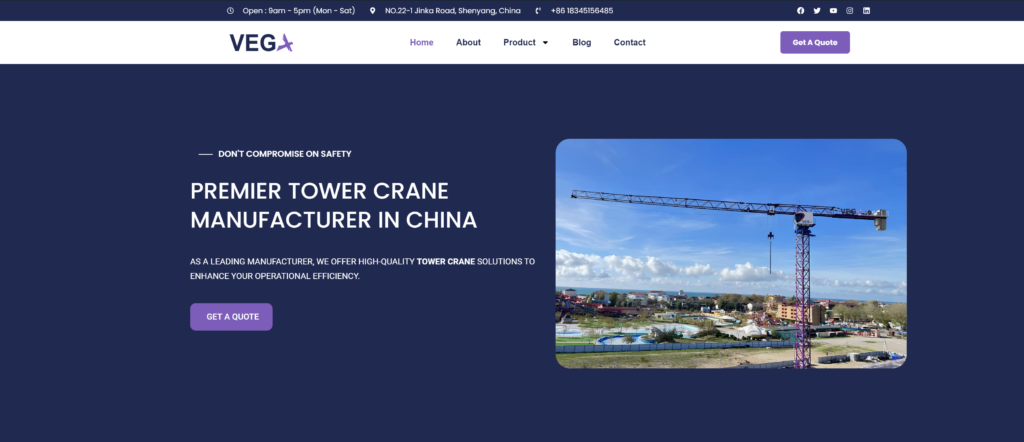
The UK’s tower crane market is highly regulated, competitive, and technologically evolving. For construction firms and developers, understanding the market landscape, safety requirements, and emerging trends is essential for making the right investment. This article provides practical insights into the UK tower crane industry, including leading suppliers, regulations, purchase considerations, and future trends.
1. UK Tower Crane Market Overview: Demand and Growth

The UK tower crane market1 is driven by urban expansion, high-rise development, and major infrastructure projects. Tower cranes are an essential part of the UK’s construction sector, particularly in cities like London, Manchester, and Birmingham, where land is scarce, and vertical construction is the only solution.
Key Drivers of Tower Crane Demand in the UK:
- High-rise residential and commercial projects due to urban housing shortages.
- Infrastructure projects, including Crossrail, HS2, and major motorway upgrades.
- Prefabrication and modular construction, requiring precise lifting solutions.
| Sector | Why Tower Cranes Are Needed | Market Impact |
|---|---|---|
| High-rise construction | Limited ground space, increased demand for vertical lifting | Rising need for high-capacity cranes |
| Infrastructure projects | Heavy material handling, complex lifting requirements | Growth in heavy-duty crane use |
| Modular construction | Prefabricated sections require precision lifting | Increasing demand for advanced lifting solutions |
The UK’s strict construction timelines2 and space constraints make tower cranes indispensable for efficient project execution.
2. Regulations and Compliance for Tower Cranes in the UK

The UK has some of the strictest crane regulations in Europe, ensuring safety, reliability, and compliance with environmental standards. Any manufacturer exporting to the UK must meet these requirements before cranes can be deployed on UK construction sites.
Key UK Regulations for Tower Cranes:
- LOLER 1998 (Lifting Operations and Lifting Equipment Regulations) – Ensures all lifting equipment is properly maintained and inspected.
- PUWER 1998 (Provision and Use of Work Equipment Regulations) – Covers crane operator training and safety compliance.
- BS 7121 (British Standard for Safe Use of Cranes) – Provides guidelines for crane erection, operation, and dismantling.
- CE and UKCA Marking – All cranes must meet European (CE) or UK post-Brexit safety standards (UKCA).
| Regulation | Requirement for Manufacturers |
|---|---|
| LOLER 1998 | Cranes must undergo regular inspections and load testing |
| PUWER 1998 | Ensures operator training and safe equipment use |
| BS 7121 | Specifies safety guidelines for crane operations |
| CE/UKCA Certification | Required for imported cranes to enter the UK market |
For Chinese crane manufacturers looking to enter the UK market, it is essential to ensure full compliance with these regulations and partner with certified distributors.
3. Preferred Tower Crane Types in the UK

The UK market favors specific tower crane types based on urban construction constraints, lifting capacity, and operational flexibility.
Most Common Tower Crane Types in the UK:
- Luffing Jib Tower Cranes – Essential for dense urban projects, allowing jibs to be lifted vertically when space is limited.
- Flat-Top Tower Cranes – Used for projects with multiple cranes operating simultaneously due to their compact design.
- Self-Erecting Tower Cranes – Preferred for smaller residential and infrastructure projects due to their quick setup.
| Tower Crane Type | Why It’s Used in the UK | Best For |
|---|---|---|
| Luffing Jib Crane | Works in tight urban spaces, avoids airspace restrictions | High-rise and city center construction |
| Flat-Top Tower Crane | No mast head, allowing multiple cranes to operate on-site | Large commercial and infrastructure projects |
| Self-Erecting Crane | Quick deployment, compact size | Small-scale residential and modular projects |
For crane manufacturers, offering customized solutions that prioritize efficiency, compliance, and modular designs is key to competing in the UK market.
4. Key Tower Crane Suppliers in the UK

The UK’s tower crane market is dominated by major European manufacturers, but Chinese brands are gaining market share by offering cost-effective, high-performance cranes.
Leading Tower Crane Suppliers in the UK:
- Liebherr (Germany) – Market leader in high-performance cranes.
- Wolffkran (Germany) – Specializes in luffing jib and flat-top cranes.
- Terex (USA) – Known for large-scale infrastructure projects.
- Jaso (Spain) – A strong player in the luffing jib segment.
- Chinese manufacturers (Zoomlion, XCMG, and others) – Increasing presence due to competitive pricing and improved quality.
| Supplier | Key Strengths in the UK Market | Market Focus |
|---|---|---|
| Liebherr | Advanced technology, premium cranes | High-rise and infrastructure projects |
| Wolffkran | Specializes in urban construction cranes | City-based commercial projects |
| Terex | Large lifting capacities | Industrial and heavy-duty projects |
| Jaso | Competitive pricing, strong luffing cranes | Urban high-rise projects |
| Chinese Brands | Cost-effective, improving compliance | Entering mid-range market segment |
For Chinese crane manufacturers, gaining market share requires strong compliance, localized support, and strategic partnerships with UK contractors.
5. Future Trends in the UK Tower Crane Market

As the UK’s construction industry evolves, several emerging trends are shaping the future of tower crane technology.
Key Industry Trends:
- Sustainability & Electric Tower Cranes – Growing demand for eco-friendly, low-emission cranes.
- Automation & Remote Operation – Interest in semi-autonomous cranes for improved safety and efficiency.
- BIM Integration – More firms are integrating Building Information Modeling (BIM) for crane planning.
| Trend | Impact on UK Construction |
|---|---|
| Electric Cranes | Reduces carbon footprint, aligns with sustainability targets |
| Remote-Controlled Cranes | Improves safety and operational efficiency |
| BIM and Smart Monitoring | Enhances project planning and crane utilization |
Manufacturers offering smart, eco-friendly, and high-tech cranes will have a strong competitive edge in the UK market.
Conclusion
For construction companies investing in tower cranes in the UK, understanding market trends, compliance regulations, and preferred crane types is essential. Here’s a quick summary:
| Key Insight | Why It Matters |
|---|---|
| Market Demand | High-rise, infrastructure, and modular construction drive crane needs |
| Compliance & Safety | Strict UK regulations require CE/UKCA certification |
| Preferred Crane Types | Luffing jib and flat-top cranes dominate in urban projects |
| Key Suppliers | European brands lead, but Chinese manufacturers are gaining ground |
| Future Trends | Sustainability, automation, and BIM integration will shape the industry |
For Chinese tower crane manufacturers, success in the UK depends on compliance, innovation, and offering cost-effective, high-performance cranes that cater to urban and infrastructure projects.



